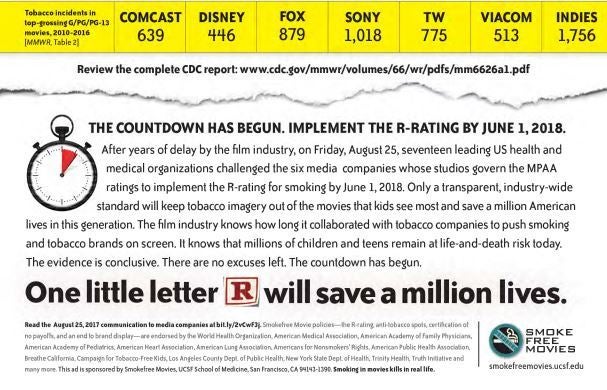
In the early days of Hollywood, the visionaries behind moving pictures realized something.
Not only would their new form of entertainment become embedded in the culture. So would the ideas, activities and products featured on the screen.
They’d be trend-setters.
Unfortunately, one of the ideas they chose to sell was smoking.
For nearly a century, actors and actresses have portrayed the notion that smoking is cool. It’s continued despite the Surgeon General’s warning in 1964 that there was a link between smoking and heart disease.
The most startling thing is that smoking continues to appear in movies rated G, PG and PG-13 – those aimed at the most impressionable audiences – even though the Surgeon General warned in 2012 that smoking onscreen causes kids to smoke.
Big Tobacco is trying to get our kids hooked early and Hollywood is helping them succeed.
A July report from the Centers for Disease Control and Prevention shows the situation is getting worse.
“If current trends continue, 5.6 million youths who are alive today are projected to die from tobacco-related diseases,” the report reads.
Now the good news: A pack of advocates, led by Dr. Stanton Glantz, is working hard to reverse that trend.
***
Let’s start at the beginning, in the Roaring ‘20s, when men wore bowler hats, audacious women were called flappers and “The Jazz Singer” introduced the feature-length talking picture.
The so-called talkies were a hit, and the tobacco companies hitched their product to them. Actors and actresses, and the movies they appeared in, were featured in cigarette advertisements. This created the impression that everyone was smoking – or, at least, everyone important.
Glantz is a professor of medicine at the University of California, San Francisco, and the director of its Center for Tobacco Control Research and Education. His research uncovered a disconnect between how much people smoked back then and how much we think they smoked back then.

Dr. Stanton Glantz
“The truth is, in the 1930s, the percentage of smokers was low,” he said. “The reason we think that everyone smoked back then is because of the movies – and many movie stars were on tobacco advertising payrolls.”
An example: In the late 1930s, Spencer Tracy received $10,000 – more than $150,000 in today’s value – to tout Lucky Strike cigarettes. Different ads promoted each of his films “Test Pilot,” “Captains Courageous” and “Mannequin.” While the maker of Lucky Strike didn’t pay the studio, the studio gladly accepted the free advertising. (Postscript: Tracy died of lung and heart problems.) Many more examples are available in the UCSF online archive.

In the 1940s, the American Medical Association and the Federal Trade Commission tried breaking the connection between the tobacco and film industries. Hollywood won and the issue went mostly dormant until the early 1980s, when Philip Morris paid to have “Superman II” feature 22 glimpses of Marlboro. Backlash included a congressional investigation.
A breakthrough came in 1998, when Big Tobacco and state attorneys general announced the landmark Master Settlement Agreement. The deal prohibited the big U.S. cigarette companies from paying to place tobacco in entertainment accessible to youths.
Still, the push to eliminate – or at least reduce – on-screen smoking failed to gain traction. Part of the problem was that the movement lacked a central force shining a bright light on the issue.
That came in 2001.
***
Beginning with a grant from the Robert Wood Johnson Foundation’s “Innovators in Substance Abuse Prevention” program, Glantz started Smokefree Movies. The campaign’s purpose is “to end the film industry's long usefulness to the tobacco industry's perpetual pursuit of new smokers.”

Glantz surmised that others agreed with his aim of keeping smoking out of youth-oriented movies, they just kept those opinions to themselves. He adopted that view after seeing it play out in the fight for clean-air laws; people didn’t like second-hand smoke, but they tolerated it until hearing others complain.
“Once the issue got out in the open, momentum grew,” he said. “The whole idea of Smokefree Movies was to do the same thing in Hollywood.”
Glantz said he had support from the foot soldiers in the industry (directors, producers, writers), but they didn’t speak out for fear of being blackballed. He doubted that would happen.
“Then we found some documents,” he said. “Their level of paranoia was justified.”
While they never shouted their opposition for all to hear, they whispered to Glantz an idea that sent him in a new direction: Instead of changing the industry, why not use Hollywood’s own voluntary rating system to get smoking out of the youth-rated movies kids see most?
That is how Glantz came up with the idea of trying to get movies that depict smoking to carry an R rating.
***
Glantz began urging the studios’ lobbying organization that controls the movie rating system, the Motion Picture Association of America, to consider smoking on par with excessive nudity, extreme violence and explicit profanity.
Smokefree Movies came up with this slogan: “Tell Hollywood to rate smoking 'R.' One little letter will save a million lives.”
Truth is, it could be more.
Using the most recent evidence, the CDC reports that 1 million children alive today will die because of smoking caused by their exposure to tobacco imagery in films rated G, PG or PG-13.
Glantz’s colleague Jonathan Polansky used CDC estimates to break down this toll by the most likely ways those children will be killed by their exposure to tobacco imagery in movies:
- 385,000 lives lost to cancer
- 375,000 to heart disease and stroke
- 265,000 to respiratory diseases
“These numbers seem outlandish to people at first until they learn that movies and TV have been an essential part of the tobacco promotional machine,” Polansky said.
If you’re wondering how this is possible since the 1998 settlement agreement bans Big Tobacco from paying to have brands showcased on screens, Glantz can provide a lengthy list of loopholes and work-arounds. This includes the settlement only covering U.S. companies; foreign tobacco makers can pay for product placement.
One more thing to note: In 2007, the MPAA began “factoring” into its ratings the glorification of tobacco use. However, the bar it uses is far lower than Glantz recommends. Not a single film has received an R rating because of smoking.
***
From 2005-2010, there was progress. Research showed fewer actors and actresses were lighting up in movies aimed at youths.
Since then, the numbers plateaued. While G and PG movies are mostly smoke-free, the imagery is on the rise in PG-13 offerings.
What happened?
“That’s the $400 million question,” Glantz said. “Had the trend continued, all youth-related films would have been smoke-free by 2015.”
His theories of what went wrong include a turnover in CEOs willing to act responsibly following the Surgeon General’s conclusion that smoking in movies caused kids to smoke, and also a rise in independent film makers, many of them in need of the money they can get for including smoking.
Another interesting trend that’s developed in recent years is that smoking use has dropped in blockbusters, but it’s up overall. This mean that while it’s more likely for a movie to depict smoking, it’s less likely to happen in the most-seen movies.
***
A few weeks ago, my organization, the American Heart Association, and 16 other leading health and medical organizations sent a letter putting the six media companies behind the MPAA on the clock. We asked them to implement the R rating for movies depicting smoking by June 1, 2018.
“We offer you a golden opportunity to resolve your decades-old problem through a lifesaving, industry-wide standard, with enough lead time to avoid substantial disruption to projects entering production,” the letter reads. “You have tried everything else. Now, together, let’s just do what works.”
Movies are entertainment, an escape from reality. The best films make us laugh and cry; we come away feeling more alive.
Yet the facts show that movies can lead to real deaths, too.
So to everyone in Hollywood involved in the ratings system, the choice is yours. Which side do you want to be on?

Excerpt from an ad that ran Sept. 5 in industry publications, Variety and Hollywood Reporter.
